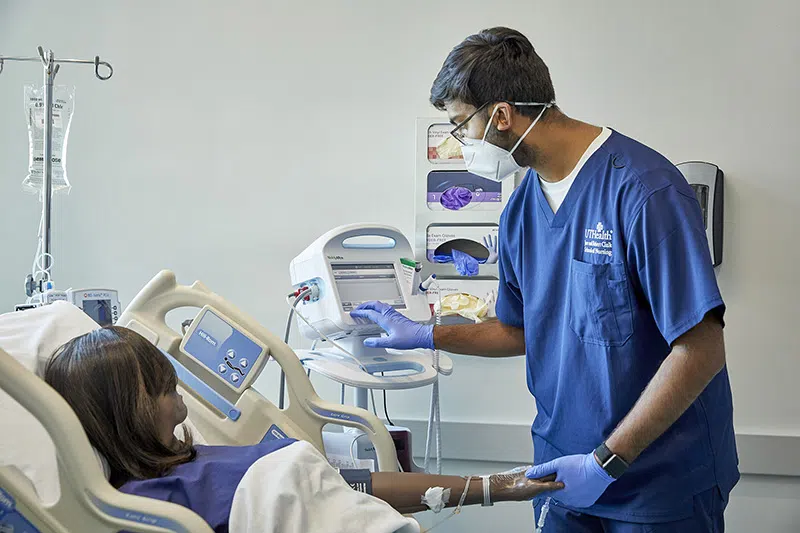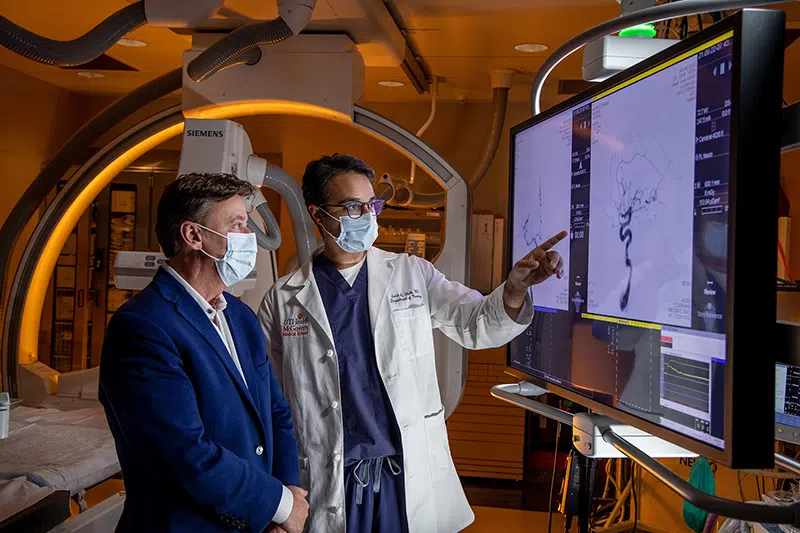POLICY
Expanded access is a potential pathway for patients with a serious or life-threatening disease or condition to access an investigational medical device that has not been approved or cleared by the FDA for treatment outside of clinical trials when no comparable or satisfactory alternative therapy options are available.
Approval by the IRB (by full board or by concurrence of an IRB chairperson), as well as approval by FDA, must be obtained prior to expanded access use of an investigational medical device to treat a patient. For emergency expanded access uses, prior approval by FDA is not required if all emergency use criteria are met, but the physician must submit a follow-up report to FDA within 5 days of the emergency use of the device.
Key Terms
Expanded access is a potential pathway for patients with a serious or life-threatening disease or condition to gain access to an investigational medical device (i.e., a product that has not been approved or cleared by FDA) when no comparable or satisfactory alternative therapy options are available. The primary purpose of expanded access is to diagnose, monitor, or treat a patient’s disease or condition, and expanded access use is outside of clinical trials and is not intended to obtain information about the safety or effectiveness of the medical device. Expanded access is sometimes informally called “compassionate use”; however, this term is not defined or described in the FDA regulations.
Expanded access for emergency use is a subset of expanded access where there is an emergency that requires the patient to be treated with an investigational device before a written submission can be made to FDA.
Emergency use for the purposes of 21 56.104(c) (the regulation on exemption from prior IRB approval for emergency use) means the use of an investigational device in a human subject in a life-threatening situation in which no standard acceptable treatment is available and in which there is not sufficient time to obtain IRB approval (21 56.102(d)). Life-threatening for the purposes of 21 56.104(c) and 21 CFR 56.102(d) includes the scope of both life-threatening and severely debilitating. Note this policy requires that the physician receive IRB approval (by full board or by concurrence of an IRB chairperson) before starting emergency use expanded access treatment.
Life-threatening for the purposes of 21 CFR 56.104(c) and 21 CFR 56.102(d) means diseases or conditions where the likelihood of death is high unless the course of the disease is interrupted and diseases or conditions with potentially fatal outcomes. The condition does not need to be immediately life-threatening or to immediately result in death. Rather, the subjects must be in a life-threatening situation requiring intervention before the IRB has the ability to review the use at a convened meeting.
Severely debilitating for the purposes of 21 CFR 56.104(c) and 21 CFR 56.102(d) means diseases or conditions that cause major irreversible morbidity. Examples of severely debilitating conditions include blindness; loss of arm, leg, hand or foot; loss of hearing; paralysis; or stroke.
PROCEDURE
The treating physician should determine if an active protocol is available and if the patient meets the eligibility criteria before requesting for use under expanded access. If enrolling the patient in a clinical trial is not an option, the treating physician should contact the manufacturer of the investigational device to determine if the product can be made available through expanded access.
FDA specifies three categories of expanded access - Emergency Use, Individual Patient/Small Group Access and Treatment Investigational Device Exemption (IDE). Treatment Investigational Device Exemption and Small Group Access protocols are reviewed by the usual IRB procedures outlined in the policy on initial review. Procedures for IRB review of individual patient expanded access to investigational devices (for either emergency or non-emergency use) are described in this policy.
FDA Review of Individual Patient Expanded Access (non-emergency use) Investigational Devices: A physician may not treat a patient with an investigational device until FDA reviews and approves the expanded access use. If there is an IDE for the device, then the IDE sponsor (who may be the device manufacturer or a physician who has submitted the IDE to conduct the clinical study for the device) should submit an IDE supplement requesting approval for a compassionate use under section §812.35(a) to treat the patient.
The IDE supplement should include the following information. If there is no IDE for the device, then the physician may submit an individual patient FDA expanded access request containing the following information plus a description of the device from the manufacturer.
- A description of the patient's condition and the circumstances necessitating treatment (patient must have a life-threatening or serious disease or condition);
- A discussion of why there is no comparable or satisfactory alternative therapy;
- A discussion of why the probable risk of using the investigational device is no greater than the probable risk from the disease or condition (that is, why the potential patient benefit justifies the potential risks of the investigational device);
- An identification of any deviations in the approved clinical protocol that may be needed to treat the patient;
- The patient protection measures that will be followed;
- A draft of the informed consent document that will be used;
- Concurrence of the IRB chairperson
- An independent assessment from an uninvolved physician; and
- Authorization from the device manufacturer on the use of the device.
FDA Review of Individual Patient Expanded Access (emergency use) Investigational Devices: A physician may use an unapproved or uncleared device in an emergency situation without prior approval by the FDA, if the physician has determined that:
- The patient has a life-threatening condition that needs immediate treatment;
- No generally acceptable alternative treatment for the condition exists; and
- Because of the immediate need to use the device, there is no time to use existing procedures to obtain FDA approval for the use.
The physician must also assess the potential for benefit from the use of the unapproved device, and have substantial reason to believe that benefits will exist. The physician should follow as many patient protection procedures as possible. Such patient protection procedures include obtaining:
- Informed consent from the patient or a legal representative;
- Concurrence of the Institutional Review Board (IRB) chairperson;
- An independent assessment from an uninvolved physician; and
- Authorization from the device manufacturer.
IRB Review of Individual Patient Expanded Access for Investigational Devices: Submission for individual patient expanded access should be submitted via email to cphs@uth.tmc.edu. The IRB staff will assign the review to an IRB chairperson or another designated IRB member. The treating physician should submit the following information:
- A letter with an explanation of the conditions supporting the determination that the patient is in a serious or life-threatening condition that needs immediate treatment and that there is no generally acceptable alternative treatment;
- A follow up plan for monitoring the patient, taking into consideration the investigational nature of the device and the specific needs of the patient. The patient should be monitored to detect any possible problems arising from the use of the device.
- A simple informed consent document or justification for waiver of consent;
- A letter of authorization from the sponsor or manufacturer to allow the expanded access use of the investigational device by the treating physician;
- Documentation of FDA approval of the expanded access use, if available.
The IRB staff will assign the review to an IRB chairperson or another designated IRB member for review. The IRB reviewer may seek additional information or clarification from the treating physician. If the IRB chairperson agrees with the treating physician’s determination, then the IRB office will issue a letter with the determination that the situation meets the FDA regulatory requirements for individual patient expanded access use of the investigational device.
When reviewing individual patient expanded access requests for devices, the IRB chair or designated reviewer will consider the following:
- Focus the review of an expanded access request for an individual patient on assessing the risks and benefits of treatment with the investigational device for the patient involved.
- Assess the qualifications of the physician submitting the individual patient expanded access request.
- When the request is for a pediatric patient, confirm that adequate provisions are included for soliciting age-appropriate assent from children and permission from a parent or guardian.
- Confirm that the informed consent document contains the information required under the policy on informed consent. The consent form should contain a statement indicating that although the primary use of the device is for treatment, the device is investigational.
Informed Consent: The treating physician must obtain informed consent of the subject or the subject's legally authorized representative, unless waived. The requirement for informed consent may be waived by the IRB chairperson if the criteria listed below are met. The treating physician and a physician who is not otherwise participating in the treatment of the subject shall certify in writing the following criteria:
- The patient is confronted by a life-threatening and/ or severely debilitating situation necessitating the use of the investigational medical device;
- Informed consent cannot be obtained because of an inability to communicate with, or obtain legally effective consent from, the patient;
- Time is not sufficient to obtain consent from the patient’s legal representative; and
- No alternative method of approved or generally recognized therapy is available that provides an equal or greater likelihood of saving the patient’s life.
If, in the treating physician’s opinion, immediate use of the product is required to preserve the patient’s life, and if time is not sufficient to obtain an independent physician’s determination that the four conditions listed above apply, then the treating physician should make the determination and, within five working days after the use, have the determination reviewed and evaluated in writing by a physician who is not otherwise participating in the treatment of the subject.
Reporting:
- Reporting to the IRB: The treating physician must submit a written follow-up report to the IRB within 2 weeks of use of the investigational product. This report should include:
- Name of the investigational device;
- Conditions under which the investigational device was administered;
- Date and time administered;
- Any adverse events or unanticipated problems to recipient or others; and
- Outcomes, if known.
- Reporting to FDA for a non-emergency expanded access use: Within 45 days of using the investigational device, a follow-up report should be submitted by whoever submitted the original expanded access use request to the FDA. This report should present summary information regarding patient outcome and a discussion of any problems that occurred as a result of device use (problems should be reported to the reviewing IRB as soon as possible).
- Reporting to FDA for an emergency expanded access use: If there is an IDE for the device, notify the IDE sponsor [the IDE sponsor must notify the FDA of the emergency use within 5 days through submission of an IDE Report (21 CFR 812.35(a)(2))—this follow-up report should include a summary of the conditions constituting the emergency, the patient protection measures that were followed, and patient outcome information]. If no IDE exists, the physician should submit to the FDA a follow-up report within 5 days of the use of the device including: a description of device used, details of the case, and the patient protection measures that were followed.
APPLICABLE REGULATIONS AND GUIDANCE
- 21 CFR 812 Investigational Device Exemptions
- 45 CFR 46 Protection of Human Subjects
- 21 CFR 50 Protection of Human Subjects
- 21 CFR 56 Institutional Review Boards
- FDA Website - Expanded Access for Medical Devices – June 2019
REFERENCES TO OTHER POLICIES
- Initial Review
REFERENCES TO OTHER SOP
- Initial Review
ATTACHMENTS
- None
If you find errors in this document, contact clinicaltrials@uth.tmc.edu
|
Document Number:
|
101-D04
|
|
Document Name:
|
Individual Patient Expanded Access Investigational Device
|
|
Reviewed by:
|
Executive Director, Research Compliance
|
|
Effective:
|
1 Aug 2008
|
|
Revision History:
|
1 Aug 2011, 1 Jun 2016, 21 Jan 2019, 1 Jun 2021
|










